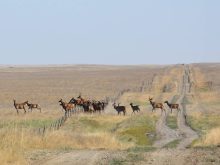Shortening the distance between nodes on an alfalfa plant reduces its height but produces the same number of flowers
BROOKS, Alta. — Researchers are testing four types of plant growth regulators on alfalfa this year to gauge their potential for shorter stands and reduced lodging.
Brad Alexander, in charge of research and extension with the Alberta Alfalfa Seed Commission, told growers on a July 24 summer tour that PGRs had shown promise in greenhouse trials so field-scale research is now underway.
PGRs could shorten the distance between nodes on alfalfa plants, reducing their height but producing the same number of flowers.
Four chemicals are being tested in southern Alberta seed alfalfa fields this year: A-Rest, B-Nine, Bonzi and Cycocel.
Read Also

Bunge’s crop mix is changing
Bunge has predominantly been a soybean processing firm, but that’s about to change after the merger with Viterra with softseed processing and grain merchandising gaining ground.
Art Folkerts, who farms south of Brooks, has provided plots for the research.
“If you can shorten the crop, shorten the nodes and increase flowers, then you would have something that the air could get in a little bit better and the bees could work a little bit better because a plant that stands straight and branches out properly is easier for a bee to work as well,” said Folkerts.
He said differences between treatments at this point in the plants’ growth are not readily apparent.
“I don’t see significance differences yet but I think it’s something that will probably show out in the plot combine. It’s something that doesn’t immediately catch the eye in here.”
Folkerts said he thinks interest in alfalfa seed production is on a downward trend, with fewer acres being grown. Improving quality and production will be key to retaining producer interest in the crop.
The alfalfa commission is also providing funds to continue research on sub-surface drip irrigation in alfalfa seed crops.
Initially funded through federal-provincial Growing Forward 2 money, the trial is now in its third year at the Crop Diversification Centre in Brooks.
Irrigation specialist Len Hingley is working with soil and water specialist Ted Harms on the project.
It involves five different irrigation treatments:
- full irrigation with 100 percent evapo-transpiration (ET) replacement
- full irrigation until the end of June and then none
- full irrigation until the end of June followed by 50 percent ET replacement
- 50 percent of ET replacement for the full season
- a dryland check
Hingley said results from last year indicated the fourth option, 50 percent of ET replacement for the full season, showed the best results but further data will be useful.
















